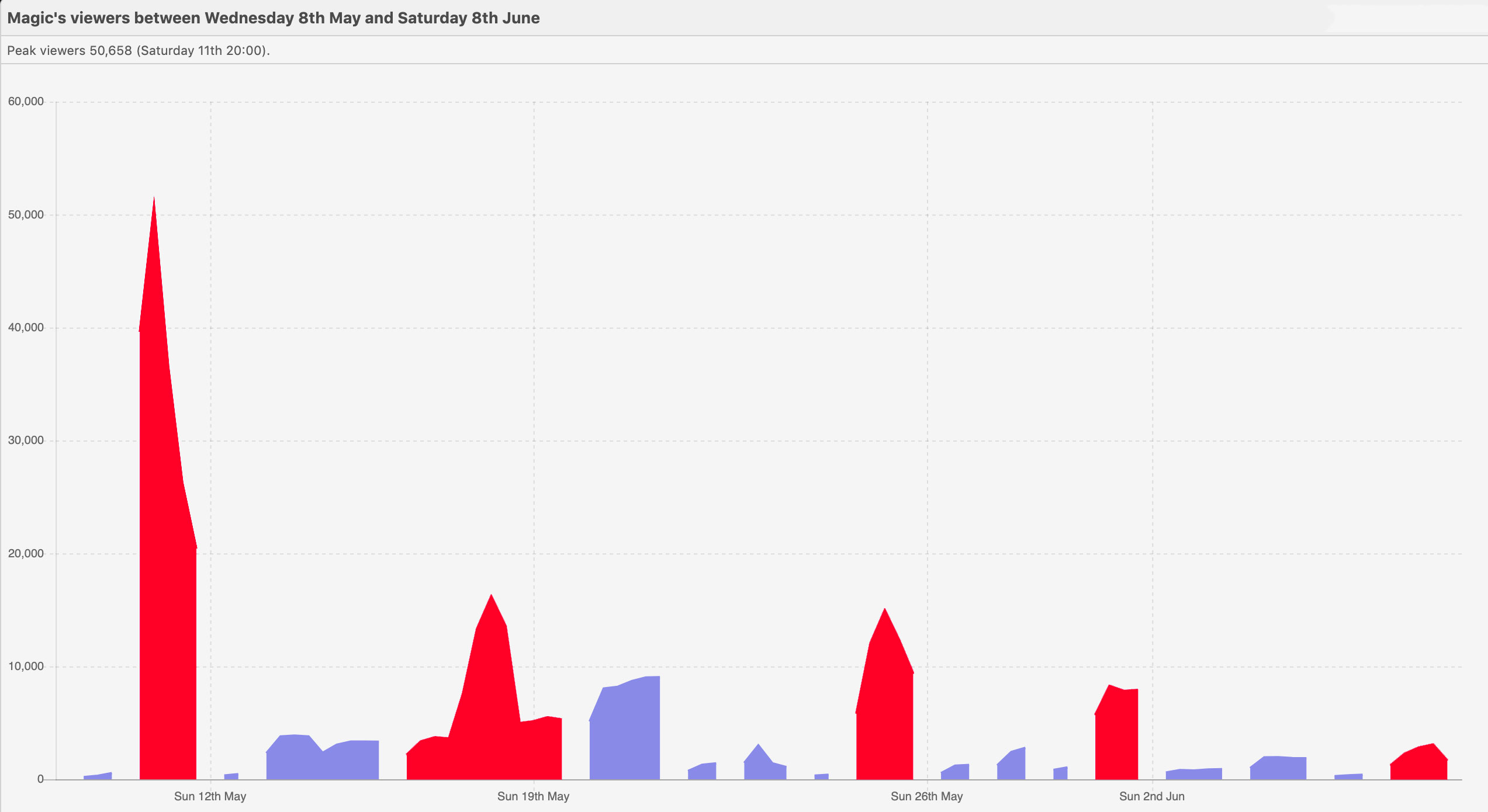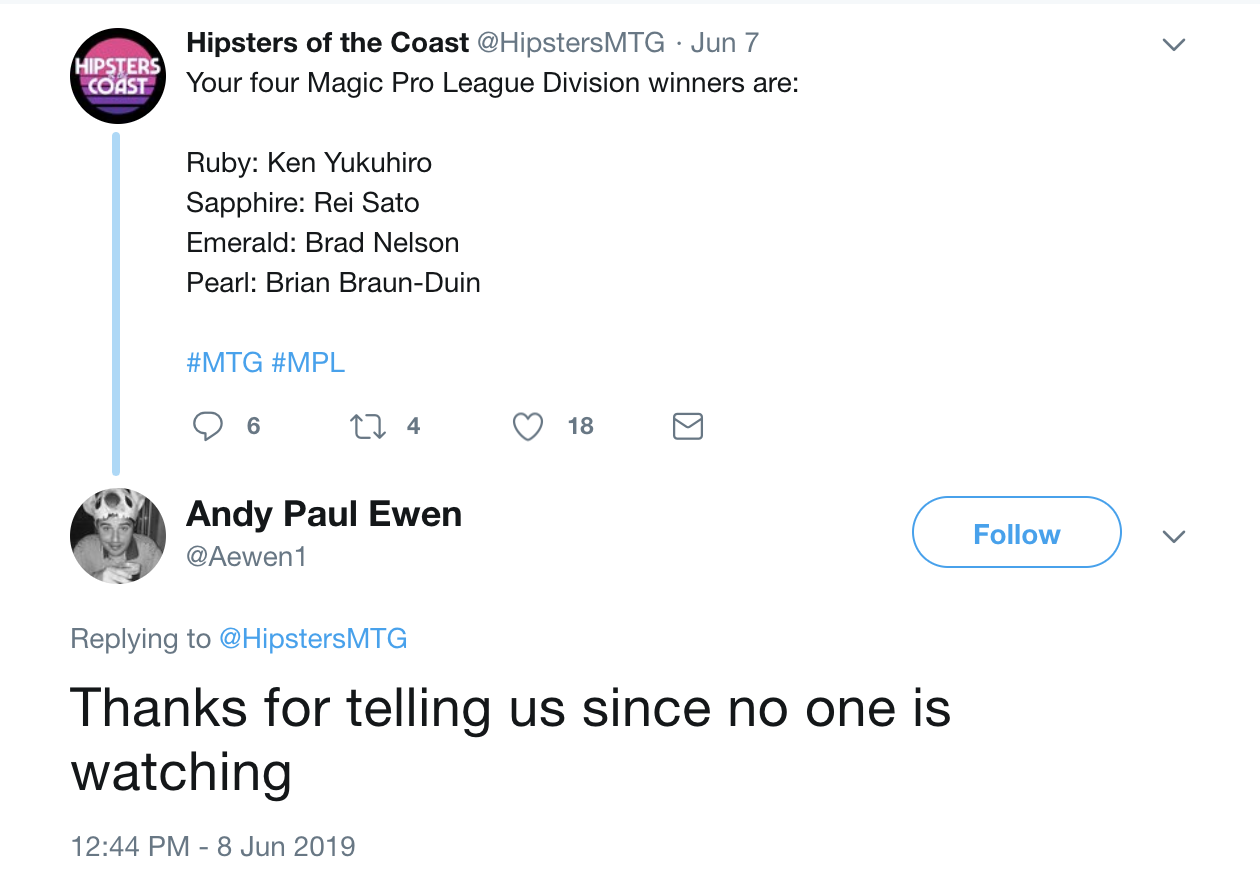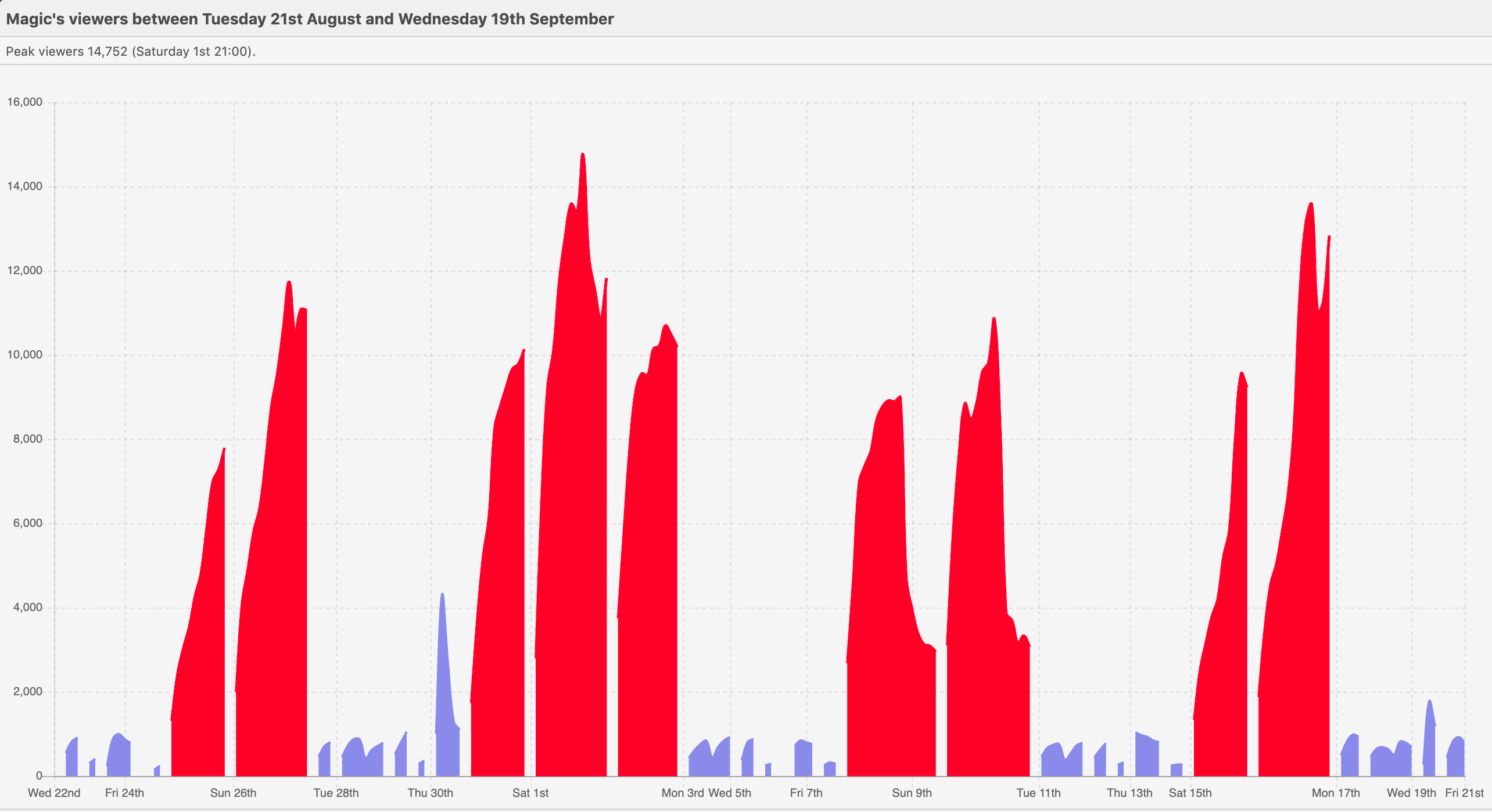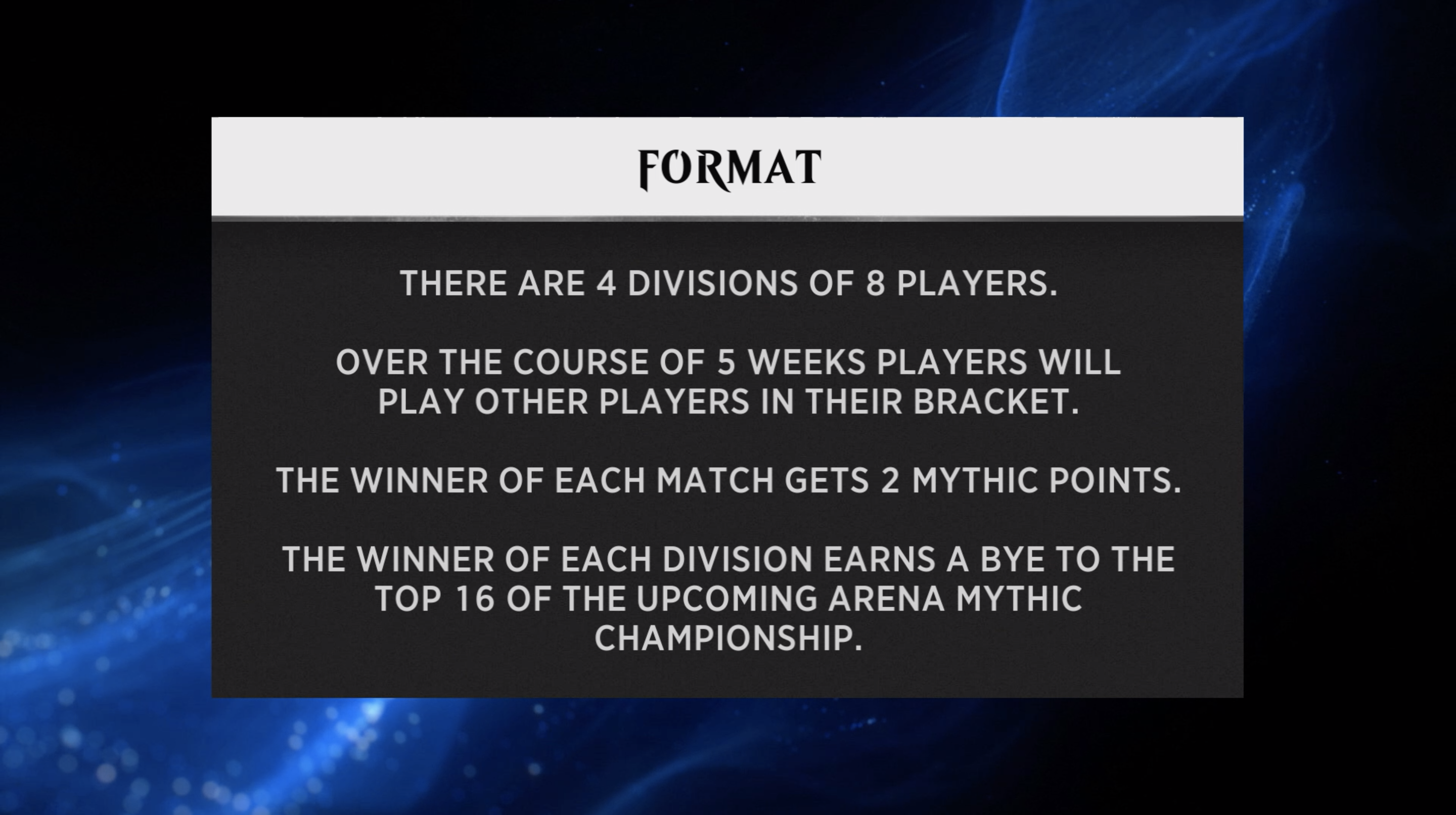The Magic Pro League’s Spark Split concluded on Friday in front of a meager audience of around 3,000 viewers. It was a disappointing end to the league’s inaugural session and a missed opportunity for the Magic Pro League as a whole, which was originally received with an intense level of hype, fanfare, and the belief that Magic had finally arrived as an esport.
Consistent Declines in Viewership

Twitch viewership of the Magic’s Twitch channel. Each of the five weeks of the MPL’s Spark Split are highlighted in red. (Source: SullyGnome)
The Magic Pro League’s Spark Split started with a strong MPL Weekly broadcast for Week 1 that peaked at over 50,000 viewers on Twitch. Those numbers quickly fell off, though, with Week 2 peaking at 16,000 viewers, Week 3 at 15,000, Week 4 at 8,000, and Week 5 at 3,000.
The decline in viewership for the Spark Split finale was precipitous, even accounting for the fact that Week 1’s view count was boosted by paid stream embeds on the Curse Network’s Gamepedia sites and being featured on the Twitch homepage. As one reader told Hipsters of the Coast, “Thanks for telling us [who won each MPL division] since no one is watching.”

The drop in viewership all the way to 3,000 viewers was particularly stark when compared to the other streams that were live at the same time as Week 5 broadcast. MPL Weekly, which is supposed to showcase of Magic’s best players competing the Magic Pro League, pulled slightly more viewers than popular streamer NumotTheNummy and barely more than half the number of viewers of Star City Games Invitational.

The Magic directory on Twitch during Week 5 of MPL Weekly.
So what caused the huge drop in viewership over the course of the Spark Split? Well, it wasn’t the quality of the MPL Weekly show itself—indeed, Becca Scott was an excellent host, the various commentators were top-notch, the matches of Magic that were shown were extremely high-level, and the production team put together an all-around solid show.
Instead, it was a combination of unclear coverage changes, personnel issues, missing or hard-to-find information, and dissatisfaction from players themselves that put the Magic Pro League’s Spark Split was put in a precarious position before a single match of Magic was even played.
Troubled From the Start
Such an anticlimactic ending to the first season of competition would have been impossible to predict when the Magic Pro League was announced in December of last year. With a league made up of 32 of Magic’s top players who were given professional contracts worth up to $75,000, it really seemed like Wizards of the Coast was ready to compete with the likes of Blizzard’s Hearthstone Championship Tour and Overwatch League.
But it didn’t take long for the Magic Pro League’s shine to begin wearing off.
The first sign of trouble game in January, when no one from the coverage team showed up to cover Grand Prix New Jersey, which sparked a mix of outrage and concern from the Magic Community. “[W]e’re adjusting our coverage for tournaments at Magic Fest[s],” Wizards said. “For New Jersey forward,” instead of live written coverage, “we’ll be posting critical end-of-tournament information on Sunday evening.” It later came out that, as part of that adjustment, Wizards would no longer provide video coverage of Grand Prix, either, with ChannelFireball agreeing to broadcast a limited number themselves.
It went unsaid at the time, but it is clear that Wizards was shifting the Grand Prix coverage budget towards producing the MPL Weekly show, which would serve to highlight the best Magic Pro League matches each week. The poor viewership numbers of MPL Weekly look even worse when compared to the Grand Prix coverage it replaced—viewership for Grand Prix usually hovered between 10,000 and 15,000 viewers, despite below average production quality.

Viewership for four Grand Prix in August and September 2018: GP Prague (Aug 25-26), GP Richmond (Aug 31-Sep 2), GP Detroit (Sep 8-9), and GP Stockholm (Sep 15-16). (Source: SullyGnome)
Roster Turmoil
While most Grand Prix weekends went uncovered, the Magic Pro League itself couldn’t even make it through Week 1 of its inaugural Spark Split without losing three of its original 32 members.
Two weeks before the Magic Pro League was to debut, Wizards removed Hall of Famer Owen Turtenwald from the league after reports surfaced that he had allegedly “exhibited a pattern of predatory behavior toward female Magic players.” That same weekend, Hall of Famer Yuuya Watanabe was caught marking cards at Mythic Championship II London and was removed from both the Magic Pro League and the Hall of Fame in a little more than a week later.
As if two players getting fired wasn’t enough turmoil before Week 1 of the Magic Pro League even aired, fan-favorite Gerry Thompson announced that he was resigning from the league, as well. Thompson said that he “joined the Magic Pro League in the first place because it seemed easier to make a difference from the inside.” But five months after it was announced that he would be a part of the MPL, Thompson believed that “[t]he lack of transparency and unwillingness to listen to feedback continue to be huge issues.”
Those three slots were filled by Autumn Burchett, Jessica Estephan, and Savjz, all excellent players in their own right. But it’s difficult for potential fans to build connections with the league when three of the 32 players have to be replaced before the league really even started.
Clunky Coverage of a League with Indirect Stakes
It took five months from the Magic Pro League’s announcement to eventually reveal the league’s format, schedule, stakes, coverage, and start date.
The format and schedule of the Magic Pro League wasn’t unusual. It would be split into four divisions, within which each of the eight players would play a round robin tournament over five weeks to determine the division winners. Instead, it was the lack of direct stakes combined with strange coverage decisions that helped cause declining engagement from Magic fans.

The structure of the Magic Pro League’s Spark Split
Indirect Stakes
Rather than competing for a direct prize or title—like Magic Pro League Spark Split Champion—the 32 members of the Magic Pro League were competing for two indirect prizes: byes into Day 2 (or the Top 16) of Mythic Championship III Las Vegas and Mythic Points to qualify for the World Championship.
A bye into Day 2 of a Mythic Championship isn’t an insignificant prize, as it places those division winners above 52 other competitors, increases their minimum prize from $7,500 to $12,500, and increases the number of Mythic Points they are guaranteed, as well. Qualifying for the World Championship, on the other hand, will make the four Magic Pro League members with the most Mythic Points one of sixteen players in a $1 million tournament, which is a much larger reward.
The problem with both of these prizes is that neither of them were actually directly related to the Magic Pro League itself. Players were competing for byes and qualifications in other tournaments, meaning Magic Pro League boiled down to a complicated qualifier tournament, which was pretty far away from a true esports league that the name “Magic Pro League” promised. This lack of direct stakes failed to add any sense of drama or importance to each week’s show and didn’t give Magic fans much of a reason to tune in or care.
Clunky Coverage Decisions
The Magic Pro League’s Spark Split was also hamstrung by the decision to cram all of its coverage in a four hour weekly recap show that aired every Saturday called MPL Weekly.
The move to a recap show meant that the producers had to distill 40 or so pre-recorded matches each week into four hours. This resulted in a structure in which one match from each division was shown in full, followed by maybe a highlighted game from another match, and then short recaps of the remaining matches.
But a recap show really only works if it has other coverage to recap—and MPL Weekly suffered greatly because Wizards relied on it to carry almost the entire coverage load for the Magic Pro League. Not only did Wizards not air any matches live, but they didn’t even post the full unaired matches on YouTube, meaning the only gameplay fans could watch was from the four full matches and game highlights that were included on MPL Weekly. Did you want to watch a full match that wasn’t aired on MPL Weekly? Too bad, you’re out of luck.
These decisions had knock-on effects that, when combined with the indirect stakes of the league itself, made it the Magic Pro League difficult to engage with. You never knew if your favorite player would have their match shown on MPL Weekly or, even if their match was going to be broadcast, at what time it would be on stream. And if your favorite player’s match didn’t make it on the show, there was no way for you to go back and watch their match because the unaired matches weren’t made available. How are fans supposed to get invested in how their favorite players are doing if they can’t even watch those players’ matches?
The decision not to post every single match also meant that it was difficult for the community to build and engage with the Magic Pro League’s overarching narratives. Did Christian Hauck play particularly poorly on his way to being the only player to go winless in the Spark Split? Did his deck choices put him in a bad position each week? Or was he the victim of variance? It’s hard to know because only one of his matches made it on camera, with the rest being relegated to context-less 30-second recaps.
The pre-recorded nature of the show could have been leveraged to provide additional kinds of coverage that would have been impossible with nearly 40 live matches every week. With multiple days between each match and MPL Weekly, there were opportunities to conduct post-match player interviews or even get the pros’ opinions on the format and how the league was shaking out. But there was basically no player presence on any of the shows until Week 5, when Eric Froehlich served as commentator and was forced to provide color commentary of the match he lost to take him out of contention for the Pearl Division title.
At its core, the problem with relying on a recap show as your only vehicle for coverage is that knowing the match is pre-recorded makes the show less exciting. Part of the viewing experience of a sporting event is knowing that the outcome has yet to be determined and that we’re all watching two players or teams battle in real time. Live sports are visceral and enthralling because of that, and taking away the live aspect deadens the experience.
All of these coverage decisions lead to a clunky weekly recap show in MPL Weekly that was extremely difficult for fans to engage with and get invested in. It didn’t matter how great the hosts and commentators were or how well-produced each show was—MPL weekly didn’t give fans an opportunity to connect with the Magic Pro League. A disinterested fanbase is by far the biggest failing of the Magic Pro League’s Spark Split.
Dissatisfied MPL Members
It wasn’t just the fans that were disappointed the Magic Pro League and MPL Weekly. Many Magic pros, both inside the Magic Pro League members and out, expressed their frustrations with how the Magic Pro League’s Spark Split failed to live up to expectations.
Ben Stark, Hall of Famer and Magic Pro League member, said that his expectations had crumbled since the high that came with the Magic Pro League’s announcement. “I’m not looking forward to the future of competitive Magic right now,” Stark said on his stream. “I thought Magic was going to be an esport, not a show but . . . it looks like WOTC wants a Magic show, not an esport.”
The Magic pros that weren’t selected for the Magic Pro League are also upset that they still have no clear way to try and qualify for the next season of the Magic Pro League. “We’d like to know how things work in time to make decisions based on that information,” popular Magic pro Sam Black wrote on Twitter. “This really doesn’t seem like it should be a big ask.”
With Magic pros of all kinds dissatisfied with how the Spark Split turned out, it’s hard to blame Magic fans for tuning out.
Looking Forward to the Core Split
Many of the issues that helped sink the Magic Pro League’s Spark Split are already baked into the cake for the rest of 2019, so is there any hope for the upcoming Core and “Archery” Splits?
Yes, there is hope, because the coverage aspect of the Magic Pro League can still be salvaged. Wizards already has an excellent crew and diverse set of talent that can be used to deliver high-quality content. What remains to be seen is if they will address the structural issues that plagued the coverage of the Spark Split and failed to build an engaged Magic Pro League audience. If Wizards learns from the Spark Split’s viewership crash and rethinks its coverage strategy, the Magic Pro League’s Core and “Archery” Splits still have a chance to regain the momentum that the Spark Split squandered.

